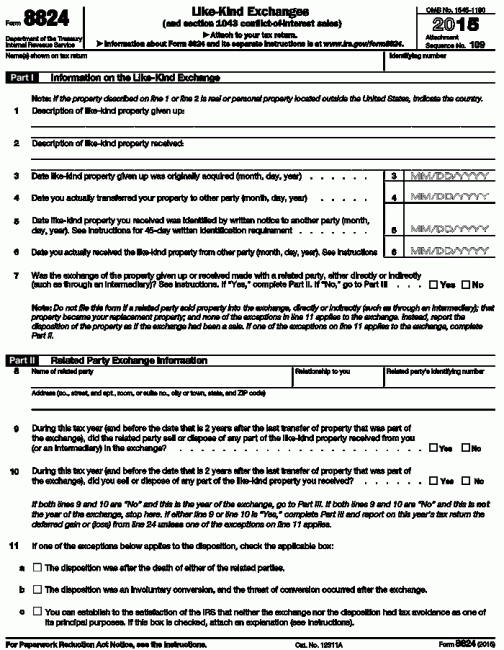BLOG
Reporting Like-Kind Exchanges to the IRS via Form 8824

There is a newer version of this post.
With the first quarter of 2016 nearly over, owners of heavy equipment are busy finalizing their 2015 financial statements. Once those financial statements are complete, accountants will be busy preparing the related tax returns. For those owners who have completed a 1031 like-kind exchange, a Form 8824 will need to be prepared and filed with the Internal Revenue Service (IRS).
What is Form 8824?
Titled, “Like-Kind Exchanges (and section 1043 conflict-of-interest sales)," Form 8824 serves two primary purposes:
- To allow business owners to report the deferral of gains through Section 1031 tax deferred exchange transactions
- To allow certain members of the Federal Government to report the deferral of gain through conflict-of-interest sales
The form is divided into four distinct parts, including:
- Part I – Information on the like-kind exchange
- Part II – Related Party Exchange Information
- Part III - Realized Gain or (Loss), Recognized Gain, and Basis of Like-Kind Property Received
- Part IV – Deferral of Gain From Section 1043 Conflict-of-Interest Sales
For the purposes of reporting any like-kind exchange activity, equipment owners need only be concerned with the first three parts of the form. Part IV is simply not required for someone that isn’t a member of the Federal Government’s executive branch, or are considered judicial officers under the same.
Part I – Information on the Like-Kind Exchange
This section covers the basics of the 1031 exchange, including:
- Description of the relinquished property (property sold)
- Description of the replacement property (property acquired)
- Date the property given up was originally acquired
- Date the property replacement property was actually received
Part one also asks if any like-kind property was either sold to, or purchased from a related party. If the answer is yes, then the form’s preparer must complete Part II. If the answer is no, then the preparer may skip Part II and move on to complete Part III.
Part II – Related Party Information
It’s interesting to note, this section does not require any calculations. It simply asks for some basic information about the related party transaction, including:
- The related party’s name, address and relationship
- Timing of any dispositions (by the related party) of the property received from the equipment owner
- Timing of dispositions related to the property acquired by the equipment owner
Background on Related Parties
Part II addresses very specific concerns regarding what is known as basis shifting. In these transactions, related parties were working together by exchanging low basis property for high basis property with the immediate plans to sell, at a gain, the lower basis property. By following this strategy, related taxpayers were effectively reducing the gain on the sale of the low basis property. For like-kind exchange purposes, related parties are defined under Internal Revenue Code Section 267(b) or 707(b)(1) and can include:
- Family members, including brothers and sisters, husbands and wives, lineal descendants, ancestors
- Individuals and corporations, where more than 50% of the value of the stock is owned directly or indirectly by or for the individual
- A corporation and a partnership if the same persons own more than 50% in the value of the outstanding stock of the corporation and more than 50% of the capital interest or profits interest in the partnership.
Part III – Realized Gain or Loss, Recognized Gain, and Basis of Like-Kind Property Received
This entire section is dedicated to determining the results of the like-kind exchange. Of the 14 total lines contained within this section, eight are simple addition and subtraction fields. This leaves the form’s preparer with some additional work to gather the data for the remaining six fields. It’s critical to avoid being fooled by the form’s apparent simplicity. The tax preparer must understand the precise meaning of this section’s terminology and each line’s requirement in order to complete the form correctly. Amongst other things, Part III will require the following:
- Fair market value and adjusted basis of other property given up
- Cash received and fair market value of other property received
- Net liabilities received by the other party
Summary
For the vast majority of exchanging equipment owners part four of Form 8824 will simply not apply, and as such it can be ignored. However, equipment owners should carefully report each and every exchange of like-kind property using the first three parts of this form. In doing so, equipment owners can effectively communicate to the IRS why the disposition(s) of their equipment, should not trigger any income taxation.
